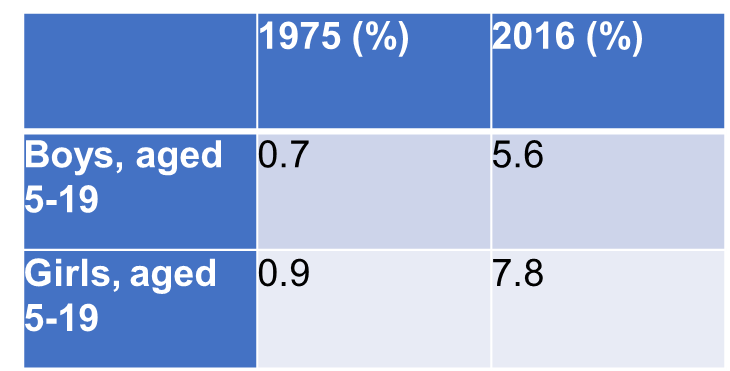Community Data Evaluation

Growth in the number of obese children from 1975 to 2016 (Jebeile et al., 2022)
The problem of obesity in children aged 5-19 does not decrease its relevance in recent years. According to Jebeile et al. (2022), since 1975, the number of obese children has increased by 4.9% among girls and 6.9% among boys.
The World Obesity Federation predicts that the total number of obese children aged 5-19 will rise to 254 million by 2030. In the USA, this number could reach more than 1 million children (Forse et al., 2019).
This problem is essential for the community as a whole, as it concerns not only childhood morbidity. Children with elevated Body Mass Index (BMI) are more likely to maintain a large body mass into adulthood, which leads to an increase in severe disabling diseases (Brown et al., 2019).
In addition to health problems, these people are likely to have problems with psychological health.
Meeting Community Needs
The situation with childhood obesity in low-income families in our area reflects the situation in the country as a whole. The most effective method of combating obesity in children in this age group is the introduction of physical activity combined with a possible diet correction (Brown et al., 2019). However, additional difficulties exist, such as families with diverse cultural backgrounds. Considering these circumstances, it is necessary to work out comprehensive measures to cover the most significant possible percentage of families.
Health Improvement Plan:
- Increasing children’s mobility by introducing additional sports clubs in schools and organizing mass sports events for families.
- Conducting community training sessions for parents to teach them the basics of proper nutrition, distributing informational materials about creating a healthy menu, and optimizing the child’s diet.
Potential difficulties in the process of work:
- Limited financial opportunities in low-income families.
- Children’s dietary preferences that are associated with the cultural and religious characteristics of the family.
- The need for specialists with relevant knowledge of diet and nutrition in this community.
- The lack of opportunities to organize sports activities near public areas, for example, outdated sports equipment in schools.
Measuring Outcomes
The goal of the planned intervention is to reduce obesity among children aged 5-19 in low-income families.
The criteria for a successful intervention will be:
- Reducing the incidence of being diagnosed with obesity in low-income children aged 5-19 years, as this would be correlated with a reduced risk of the prevalence of obesity-related diseases in this group (Brown et al., 2019).
- Reducing the average BMI values in this social group to typical values of 18.5-29.9 will indicate the intervention’s effectiveness and improve the well-being of children (Forse et al., 2019).
Communication Plan
The main stakeholders in this matter will be parents of children, healthcare professionals, children’s educational institutions, and representatives of the authorities.
Working with the parents should become the main activity. It is necessary to identify opportunities to reduce their financial burden and provide dietary educational activities.
Health workers in this concept carry out the essential task of interacting with parents and developing ideas and plans for child nutrition in accordance with their cultural and religious peculiarities.
Institutions of children’s education and leisure have the opportunity to organize additional sports events. However, they may experience material problems due to the tearing of equipment. These issues can be resolved through interaction with local authorities.
Government agencies will be interested in improving the community’s health, especially preventing severe diseases that increase the health and economical burden. Their interaction with educational and healthcare institutions will be regulatory, providing a material base and the normal organization of processes.
Value & Relevance of Evidence
From a review prepared by Jebeile et al., relevant information on risk groups for obesity among children aged 5-19 years was used to compile this plan. Some of the strategies indicated in this review can be adapted for use in our community, for example, the involvement of educational institutions in organizing additional leisure activities for children. (Non-research, literature review, Level of Evidence V)
Forse et al. provided in their review comprehensive information on the statistics of the prevalence of obesity among children, including taking into account the level of income in the family and cultural characteristics. The plan presented above is consistent with the data from this review and focuses on improving obesity in the most vulnerable group of children. (Non-research, opinion of respected authorities, Level of evidence IV)
A systematic review by Brown et al. lists the available treatments for childhood obesity according to their effectiveness with a high level of evidence. For the current Health Plan, the methods with the highest efficiency were selected following the data presented in the review. (Systematic review of RCTs, Level of Evidence I).
References
Brown, T., Moore, T. H. M., Hooper, L., Gao, Y., Zayegh, A., Ijaz, S., Elwenspoek, M., Foxen, S. C., Magee, L., O’Malley, C., Waters, E., & Summerbell, C. D. (2019). Interventions for preventing obesity in children. Cochrane Database of Systematic Reviews, 2019(7). Web.
Forse, R. A., Betancourt-Garcia, M. M., & Kissee, M. C. (2019). Epidemiology and discrimination in Obesity. The ASMBS Textbook of Bariatric Surgery, 3–14. Web.
Jebeile, H., Kelly, A. S., O’Malley, G., & Baur, L. A. (2022). Obesity in children and adolescents: Epidemiology, causes, assessment, and Management. The Lancet Diabetes & Endocrinology, 10(5), 351–365. Web.